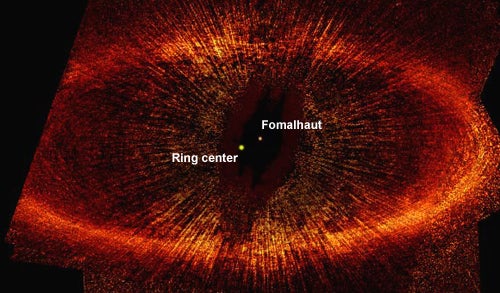Astronomers discovered 20 years ago, using infrared light, that a dust ring encircles the bright star Fomalhaut. New visual observations made with the Hubble Space Telescope, however, show the ring in much greater detail: It is narrow, it has a sharp inner edge, and it is offset from the star.
The cause of the offset, says a team of astronomers, is the gravitational pull of at least one unseen planet. The team reported its results in this week’s Science.
Many stars are known with donut-shape dust rings, says team leader Paul Kalas of the University of California, Berkeley. “What makes Fomalhaut unique is that the star isn’t located in the dust ring’s center.” The ring, he says, is offset 15 astronomical units (AU) from the star. (Earth orbits the Sun at 1 AU, Pluto at 40 AU.)
The new Hubble observations show the dust ring’s sharp inner edge lies 133 AU from the ring’s center, and the ring is about 25 AU wide. It is the Fomalhaut version of the Sun’s Kuiper Belt, a ring of icy bodies orbiting beyond the planets.
“At Fomalhaut,” says Kalas, “we have a planet with an eccentric orbit shepherding the ring.” The ring’s eccentric shape, he says, matches the shape of the planet’s orbit. The astronomers think the unseen planet orbits Fomalhaut at a distance of 50 to 70 AU. Its gravity stops dust from moving inward by gravitational perturbations.
“If the planet were as massive as five Jupiters,” Kalas tells Astronomy, “we would have detected it directly.” He adds that while theorists have just begun to work on explaining the ring, simulations using a planet of 1.8 Jupiter-masses reproduce the offset.
The planet shepherding the inner edge may not be alone. An astronomer not connected with the team, Jane Greaves of the University of St. Andrews, Scotland, comments, “I’m intrigued that the ring’s outer edge is pretty sharp as well. I’m wondering if there might be some even more distant planet.” If so, she says it would be orbiting at 160 AU or so.
First-magnitude Fomalhaut, the brightest star in Piscis Austrinus, the Southern Fish, lies 25 light-years away. Greaves notes that if there are any earthlike planets around the star, even ones in its habitable zone (5 to 10 AU), there isn’t much chance for life.
With twice the Sun’s mass, Fomalhaut is a fast-living star, she explains. Aged only 200 million years now, within a few hundred million years more, it’ll become a red giant, engulfing any inner planets.
Says Greaves, “It’s almost tragic. If any life did emerge here, and if it evolved at a speed like life did on Earth, such life will be wiped out before it becomes anything more than simple cells.”










